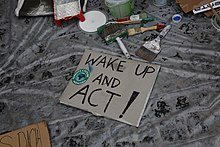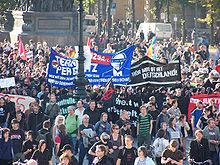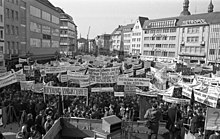Demonstration (political)
![]()
This article deals with demonstrations in the political sense. Further meanings are listed under Demo.
A demonstration (from Latin demonstrare, to show, point out, prove, short form: demo) in the political sense is a gathering of several people in public for the purpose of expressing opinions. Occasionally, demonstrations are also called marches, especially if they are in an extremist context.
In Germany, the right to demonstrate is a fundamental right enshrined in Article 8 (freedom of assembly) of the Basic Law.
The forms and actions of demonstrations can be quite diverse: they range from human chains, chains of lights, rallies, silent marches, vigils to protest actions such as sit-ins or blockades, from individual actions to mass demonstrations. They can be peaceful or violent. Demonstrations usually take place as marches or protest marches, often only or combined with a standing rally. Other special forms are for example Critical Mass, Tour de Natur or demonstrations lasting several days. New forms of protest are the online demonstration and other mass activities organized on the Internet.
Occasions and topics of demonstrations are manifold: they range from rallies against government policies, against animal testing, for peace, criticizing globalization, for environmental protection, for a certain immigration policy, for or against new road construction, against nuclear waste transports, counter-demonstrations, for trade union goals, for more university funds or against tuition fees.
In the case of serious events that endanger public safety or health, governments can apply emergency laws that restrict not only freedom of assembly but also the right to demonstrate. However, the restrictions on freedom of assembly and the right to demonstrate during the Corona Crisis are restrictions on individual fundamental rights and should not be confused with emergency laws, which are broader in scope. The emergency laws were passed on June 28, 1968. They have never been applied.

Posters and banners are part of a demonstration

Group of autonomists in a demo against the security conference in Munich 2011

Demonstrator wearing a gas mask outside the White House in Washington, D.C. during the "We Can't Wait" protests in February 2006.

Anti-nuclear human chain 2011 in Ludwigsburg
.jpg)
2011 sit-in blockade in Gorleben, against transport of nuclear fuel

Demonstration Freedom instead of Fear 2007 in Berlin
Legal
![]()
This article or paragraph presents the situation in Germany, Austria and Switzerland. Help to describe the situation in other countries.
The right to demonstrate is a fundamental right and is enshrined in Germany in Article 8 of the Basic Law. For open-air assemblies, the article allows for restrictions based on a law.
Legally, one speaks of an assembly. Lawyers distinguish between the assembly concept of the Basic Law Article 8 (which only grants "Germans the right to assemble peacefully and without weapons") and that of the simple legal right of assembly (which also grants non-Germans this right and also applies to armed or unpeaceful demonstrations).
Since the reform of federalism in 2006, the right of assembly falls under the exclusive legislative competence of the Länder. Pursuant to Article 125a (1) of the Basic Law, the Federal Assembly Act continues to apply insofar as the Länder do not replace it with their own laws. So far, only Bavaria, Lower Saxony, Saxony and Saxony-Anhalt have made full use of this possibility. Berlin has so far only enacted a law which extends the powers of the security authorities to make image and sound recordings at meetings. For the rest, the federal law on assemblies also continues to apply in Berlin.
Open-air assemblies in Germany must be registered, but not approved. There is no ban on assemblies unless the demonstration directly endangers "public safety or public order". In Austria, similar regulations apply, but here all generally accessible assemblies must be registered 24 hours in advance - i.e. also those that do not take place in the open air. Cultural and election campaign events are exempt from the obligation to register. Failure to register an assembly is punishable by an administrative fine, but this is not a reason to break up the assembly.
During demonstrations in Germany, the right of assembly, which supersedes police law as a lex specialis, applies primarily to all participants. Police measures are thus subject to narrower legal limits.
In Germany, Austria and some cantons in Switzerland, among others, there is a ban on masking at demonstrations, which prohibits participants from covering their faces or carrying certain objects for this purpose.
History
Some of the great global demonstrations in the 20th century were those against the Vietnam War. In the largest demonstration, on October 15, 1969, 250,000 people came to the demonstration in Washington, D.C. , to demonstrate against the war in Vietnam.
On October 10, 1981, about 300,000 people gathered in the Hofgarten in Bonn and demanded nuclear disarmament in a peaceful demonstration against the NATO double decision. On 25 October 1981, 200,000 people demonstrated for the same reason in Brussels, and on 21 November 1981, 400,000 people demonstrated in Amsterdam. In Bonn, on the occasion of a state visit of US President Ronald Reagan, a demonstration with about 500,000 people took place on 10 June 1982 (see also Peace Movement).
On February 15, 2003, more than 10 million people worldwide demonstrated against the impending war in Iraq, most of them in Europe. In Berlin alone, about 500,000 people took to the streets.
In non-democratic states, such as the former Eastern bloc countries, only state-ordered, state-sponsored demonstrations were allowed. Other demonstrations were violently put down (for example, on 17 June 1953 in the GDR). Another example was the 1989 student protests in the People's Republic of China, which were bloodily ended by the army at gunpoint in the Tian'anmen massacre.
The Monday demonstrations of 1989 in the final phase of the GDR were completely free of violence.
In 2007, the demonstration concept Out of Control emerged among left-oriented, anti-authoritarian groups in order to systematically complicate police operations and tactics such as walking kettles or preventive surveillance of gatherings.
With the proliferation of mobile phones and social networks, it is now possible to inform a group of like-minded people of an event and/or call them in much more quickly than in the past. This also favoured rallies in Iran and China, as well as the revolutionary upheavals in 2011 in Tunisia, Egypt and other countries (see Arab Spring).

Peasants' demonstration on Bonn's market square on 27 February 1971
Search within the encyclopedia